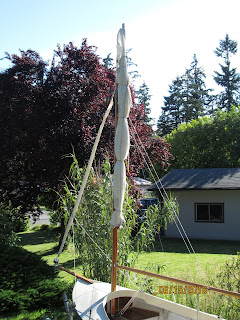Boom tents are a common way to provide overnight shelter on an open sailboat. They can also provide shade at anchor on a hot summer day. Here is how to make a simple and serviceable boom tent from an inexpensive polytarp, some plastic grommets and a little bit of duct tape. It only takes a few hours to make, and guess what? No sewing is required!
This tent is inexpensive and easy to construct. It fits and functions well, it's quick to set up, and it's bright inside.
This tent is made from heavy duty white polytarp. I recommend 12 mil thickness and go with white because it'll be brighter inside. Have you seen those 10x20 foot temporary carports? If you buy a replacement tarp for one of those it's the perfect size for this project. Do not cut the polytarp with scissors or it'll fray at the edges! Instead, use a soldering iron or hot knife along with a metal straight edge on a glass table top. This will cut and melt the edges or essentially "cauterize" them. This will prevent the tarp from fraying and save you a lot of time since no hemming is required.
Ideally the main sail should be stored outside the tent, not inside where you're sleeping. The last thing you want, after sailing in rainy weather, is a wet sail dripping on you
I lash my mainsail to the gaff and raise the whole affair up the mast prior to setting up the tent. After the tent is set up, I lower the gaff/mainsail combo back down so it rests on the boom.
The boom is supported with a boom crutch. This holds the boom in place securely. Snugging up the mainsheet and boom vang lock the boom in place. The ends of my boom crutch simply attach to the stern cleats with a loop of rope.
The tent is secured with bungee cords. The same type of bungee cords they use on those portable carports.
After the boom tent is set up, I lower the gaff (which still has the mainsail lashed to it) down so it lies atop the boom, securing it in place with a bungee cord from the end of the gaff to the mizzen mast.
When not in use, I store the boom tent under the port seat. I added quarter-turn hatches to the front of bulkhead 5 to provide a new storage area for the rolled-up tent and boom crutch.
The tent can also serve as a sun shield on hot summer days by flipping one side over the boom (folding the tent in half along the boom). My Navigator sleeps one or two in comfort using my sleeping platform.
Is there room for improvement? Of course. Fabric may be a better choice of material. Then fancy windows, doors and mosquito netting could be added. But overall I am quite pleased with the results. This boom tent started out as a temporary solution. As of this writing I've been using it for over 8 years.
You can download plans for the boom tent but you'll need to modify the measurements to fit your Navigator.





















